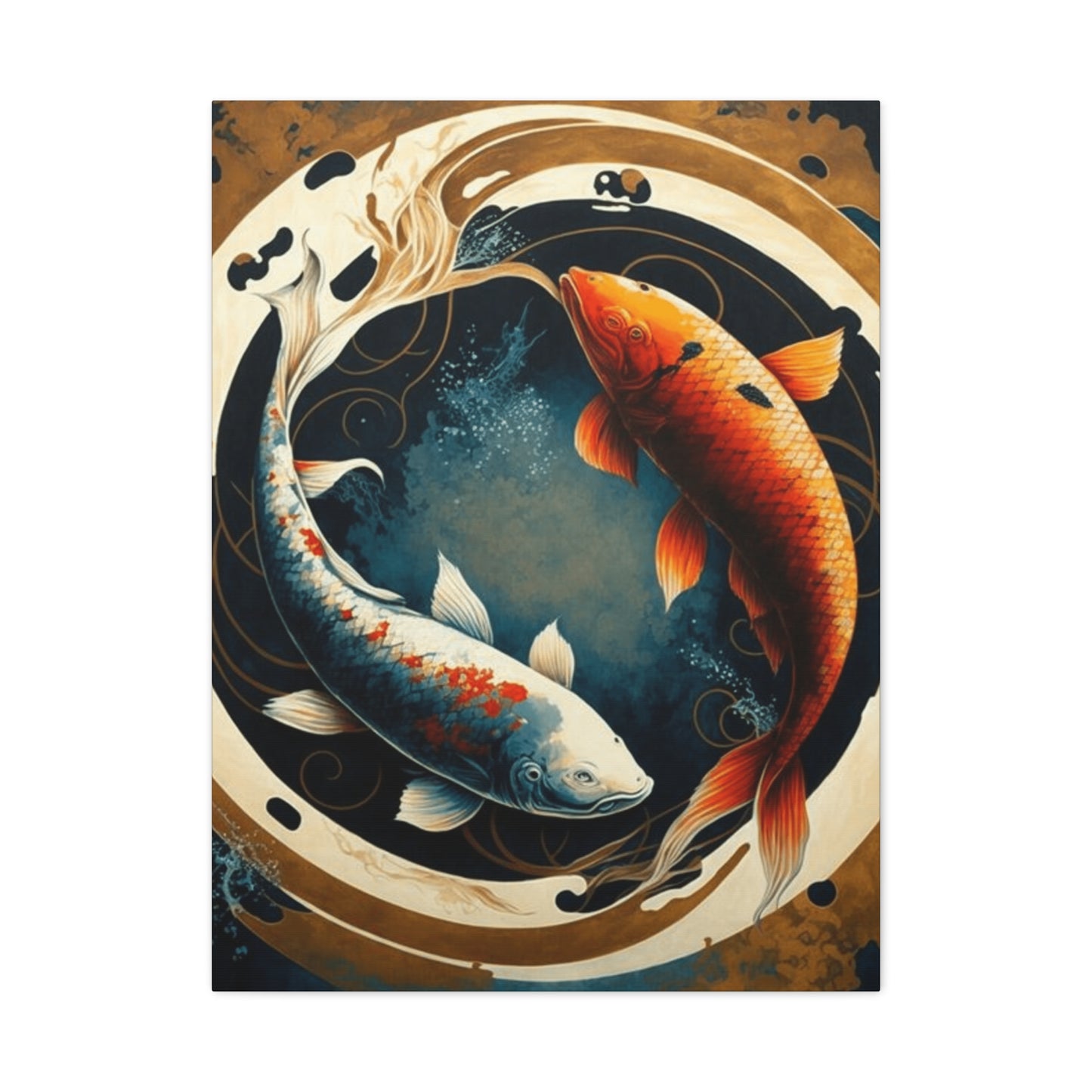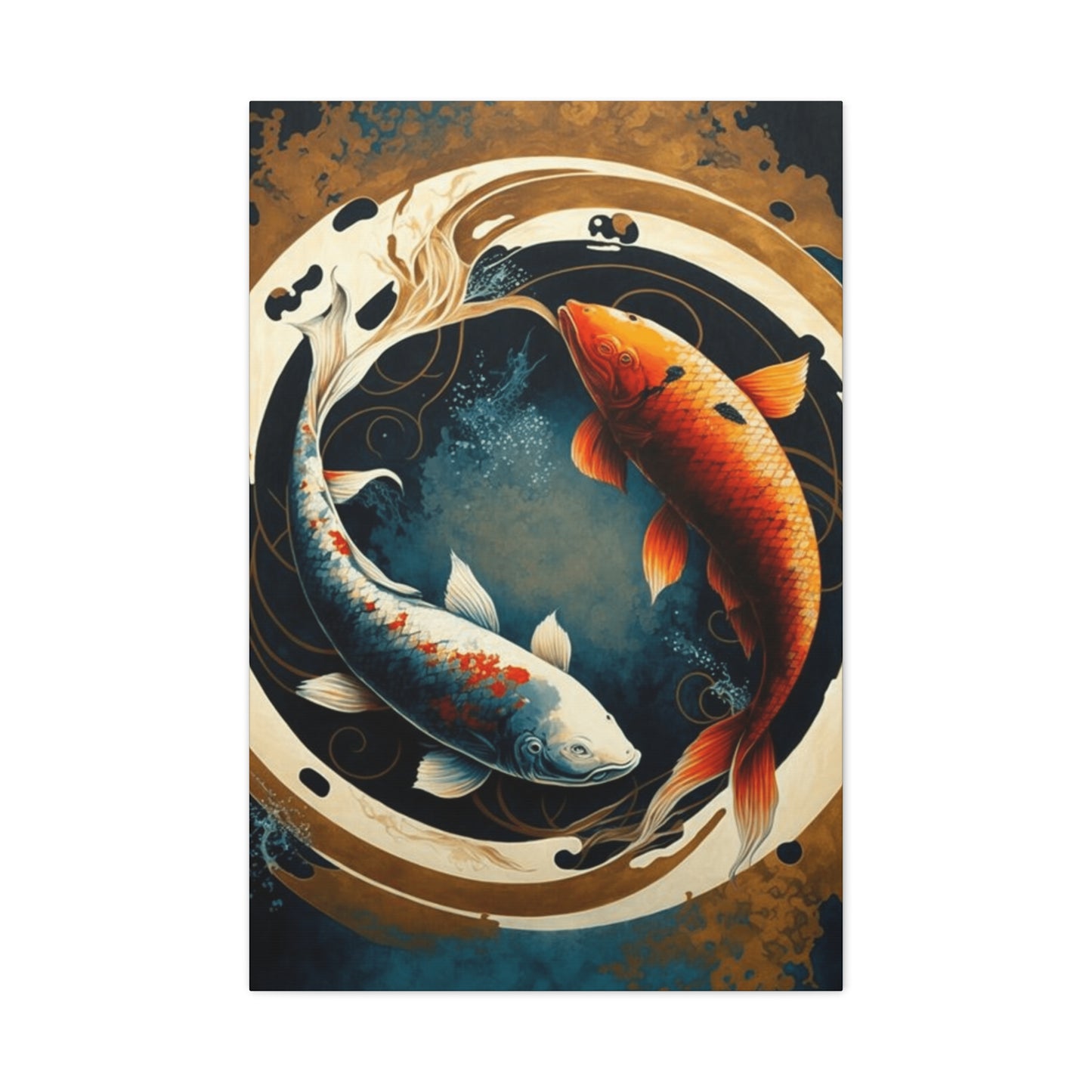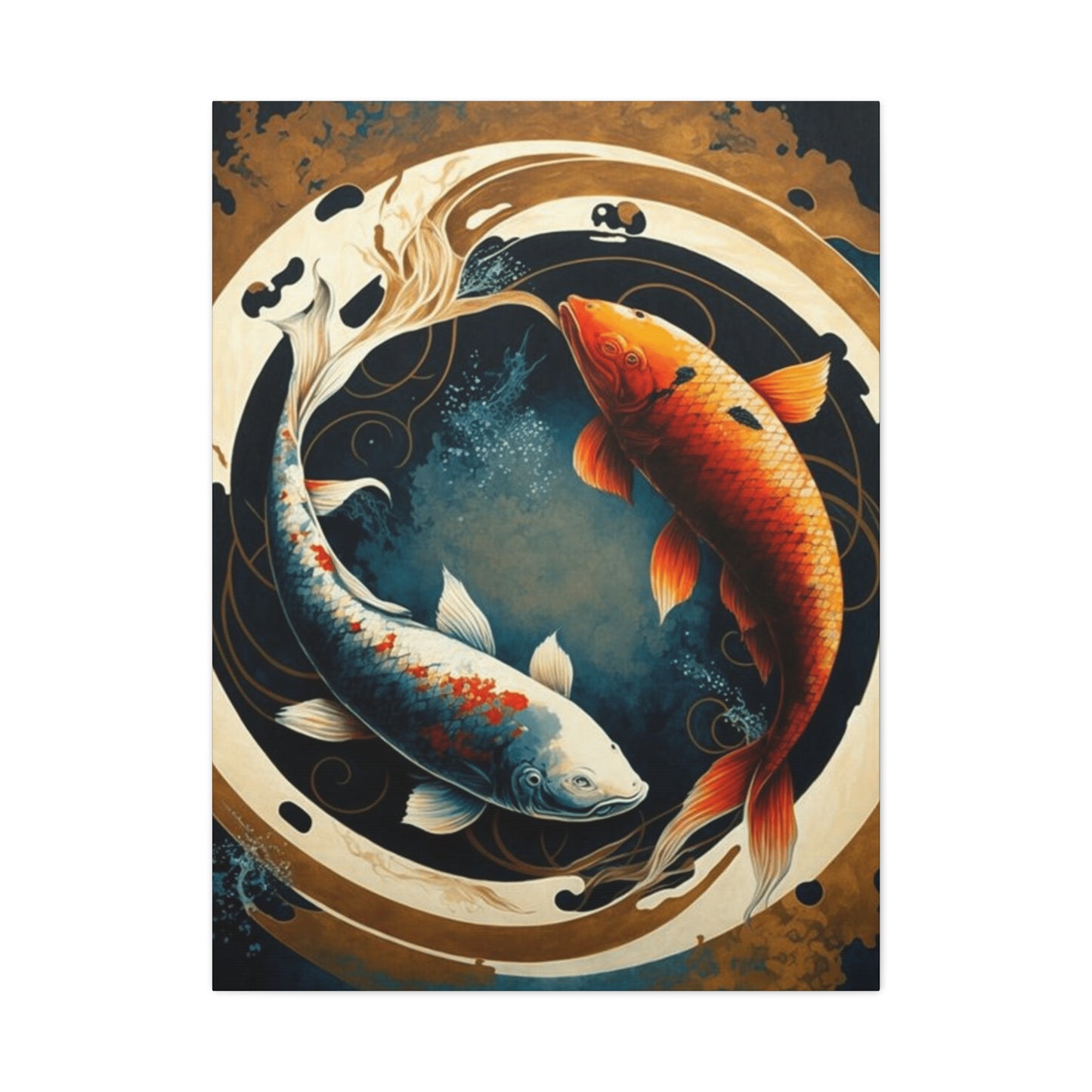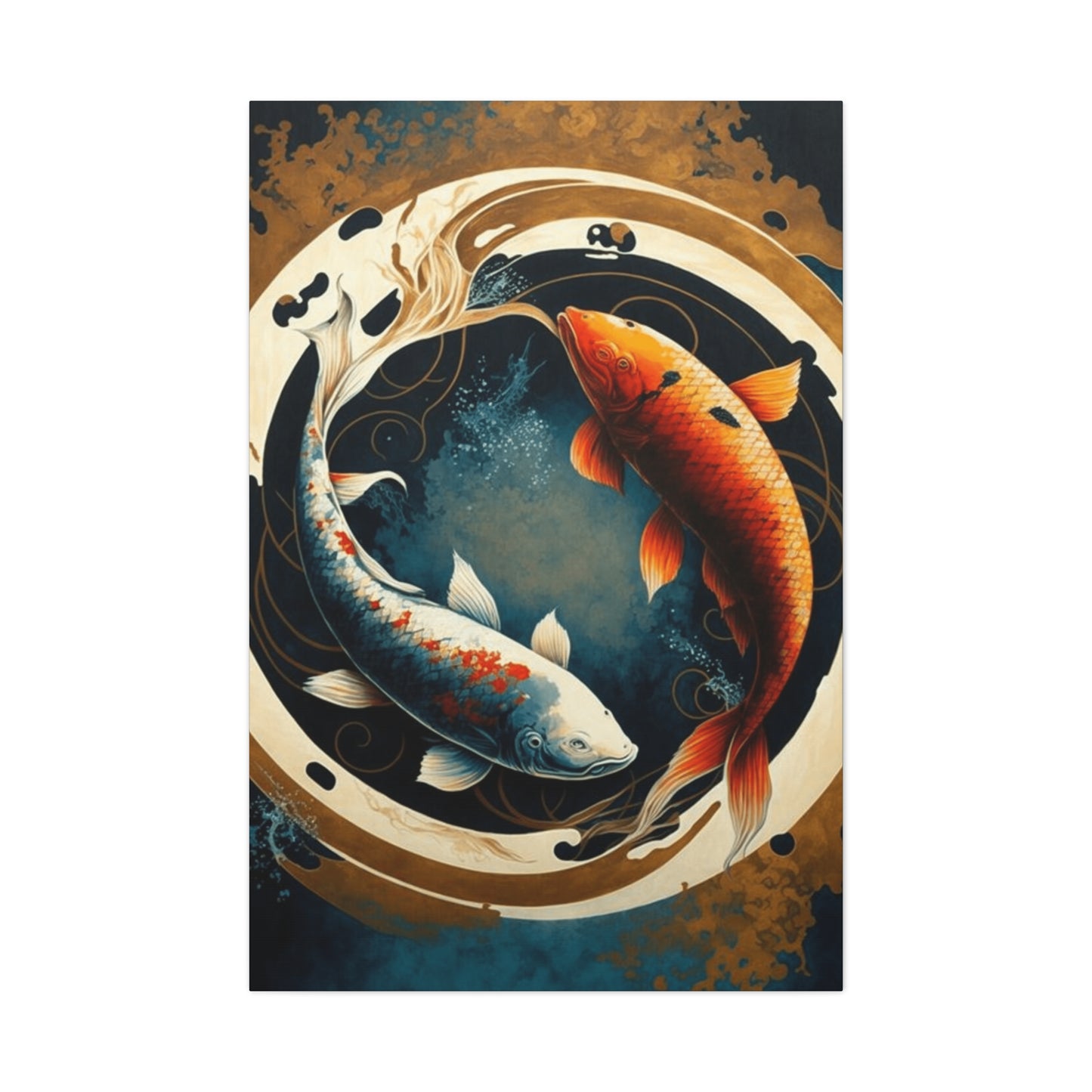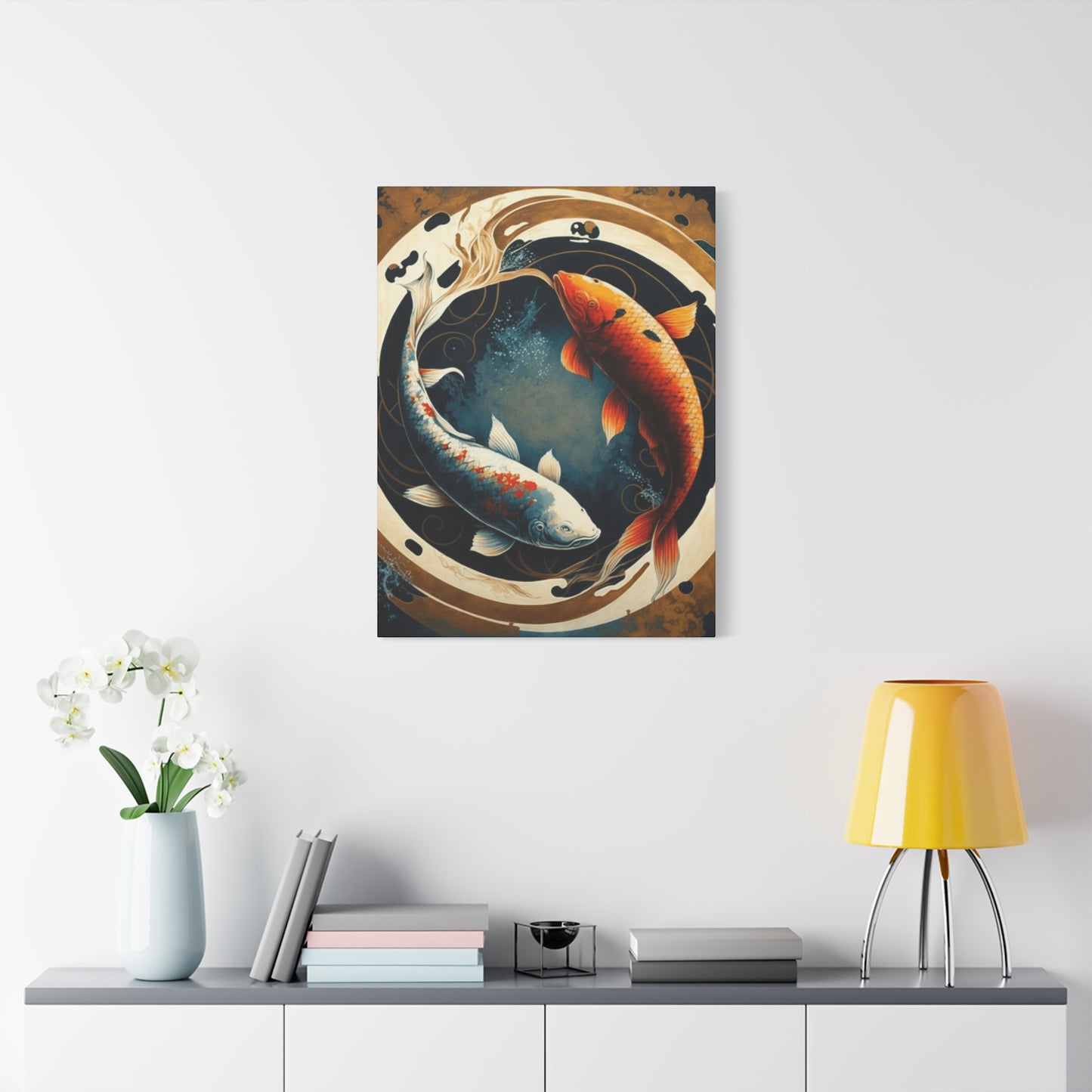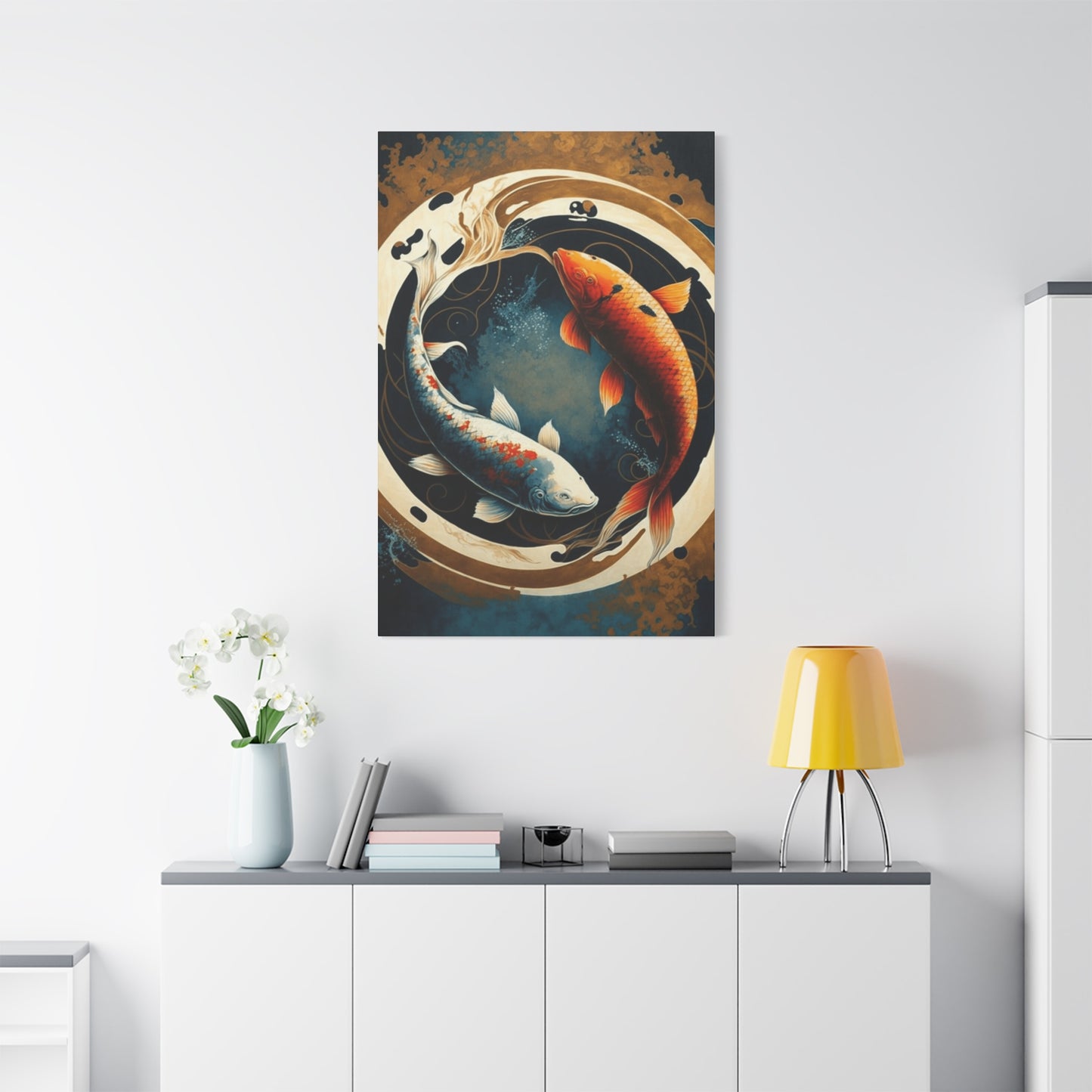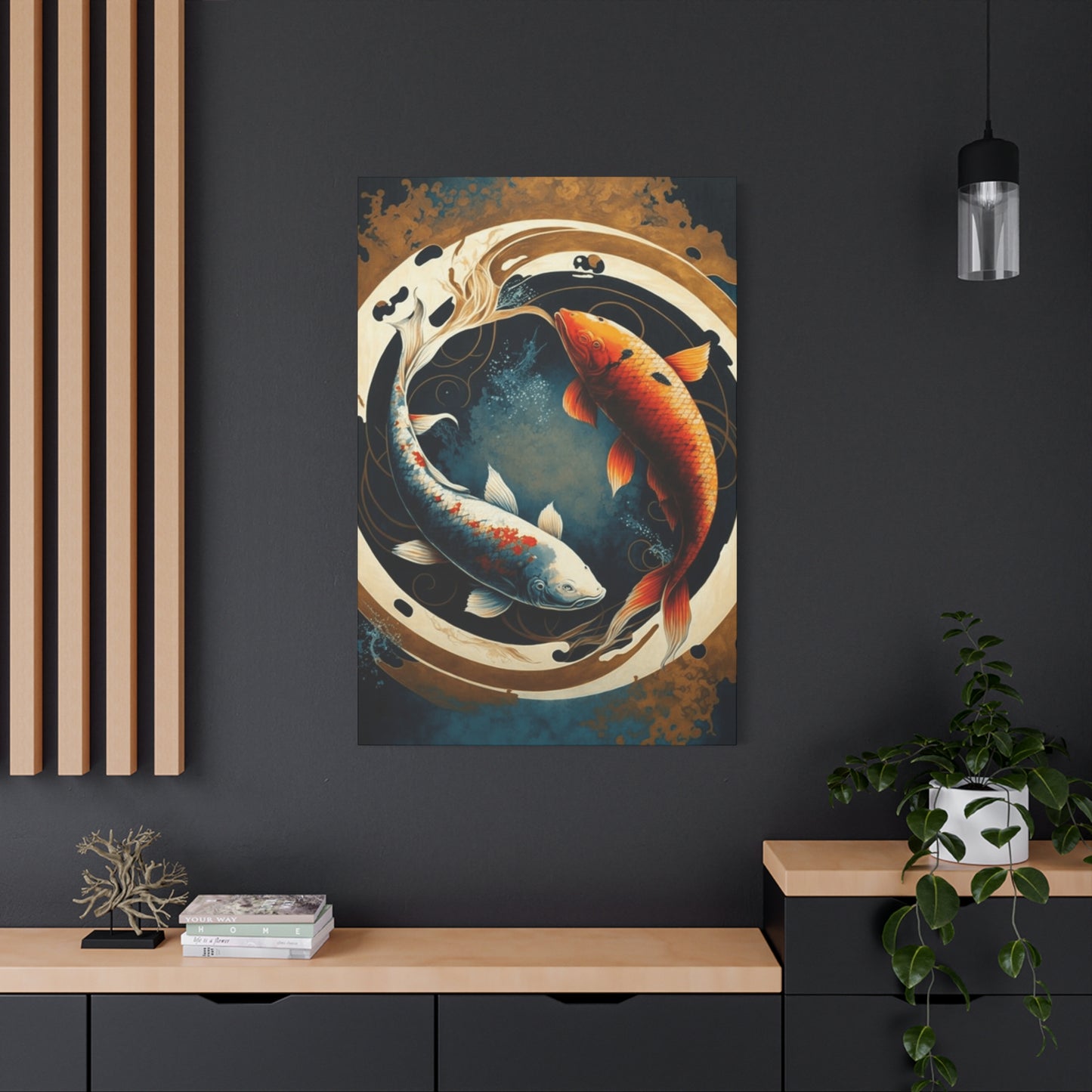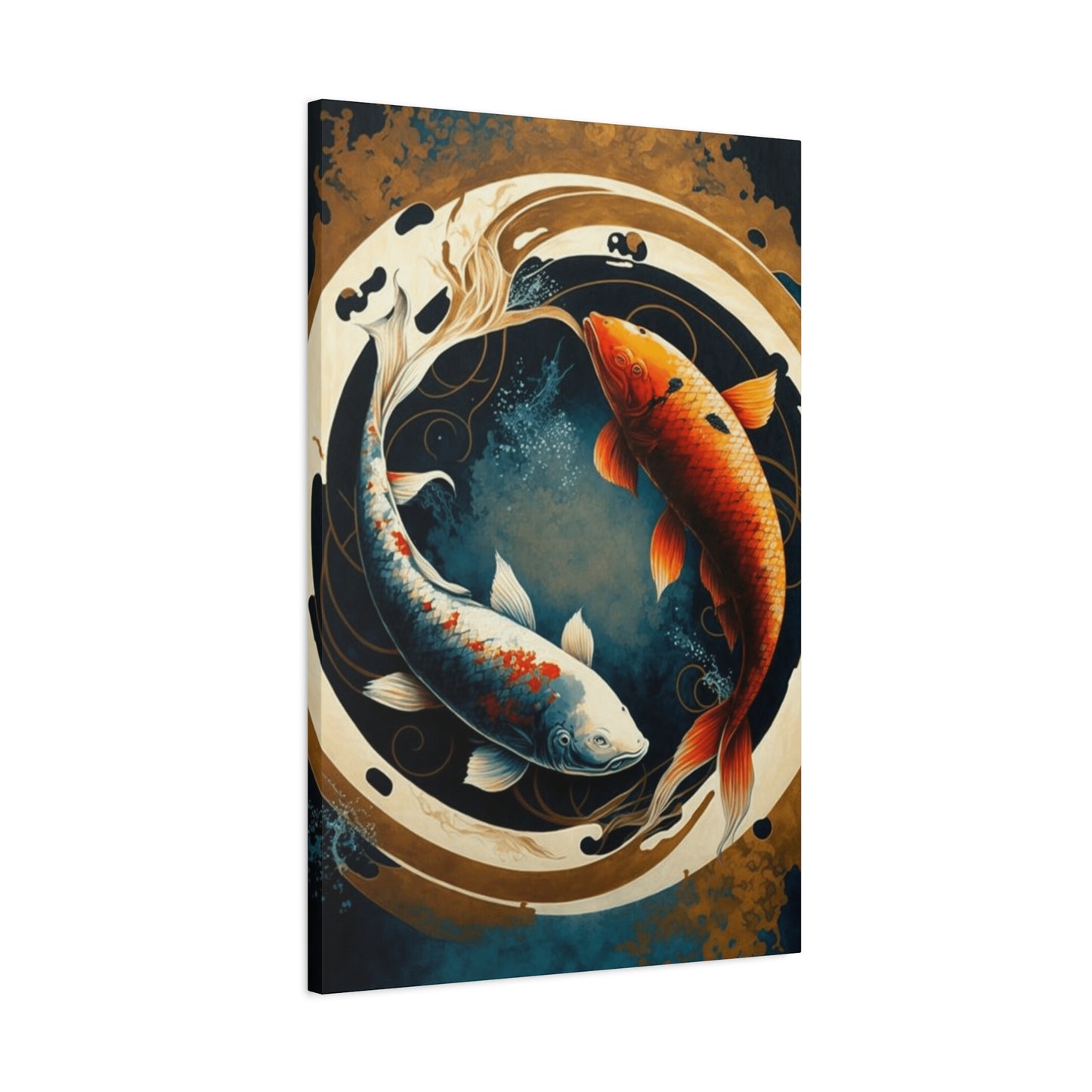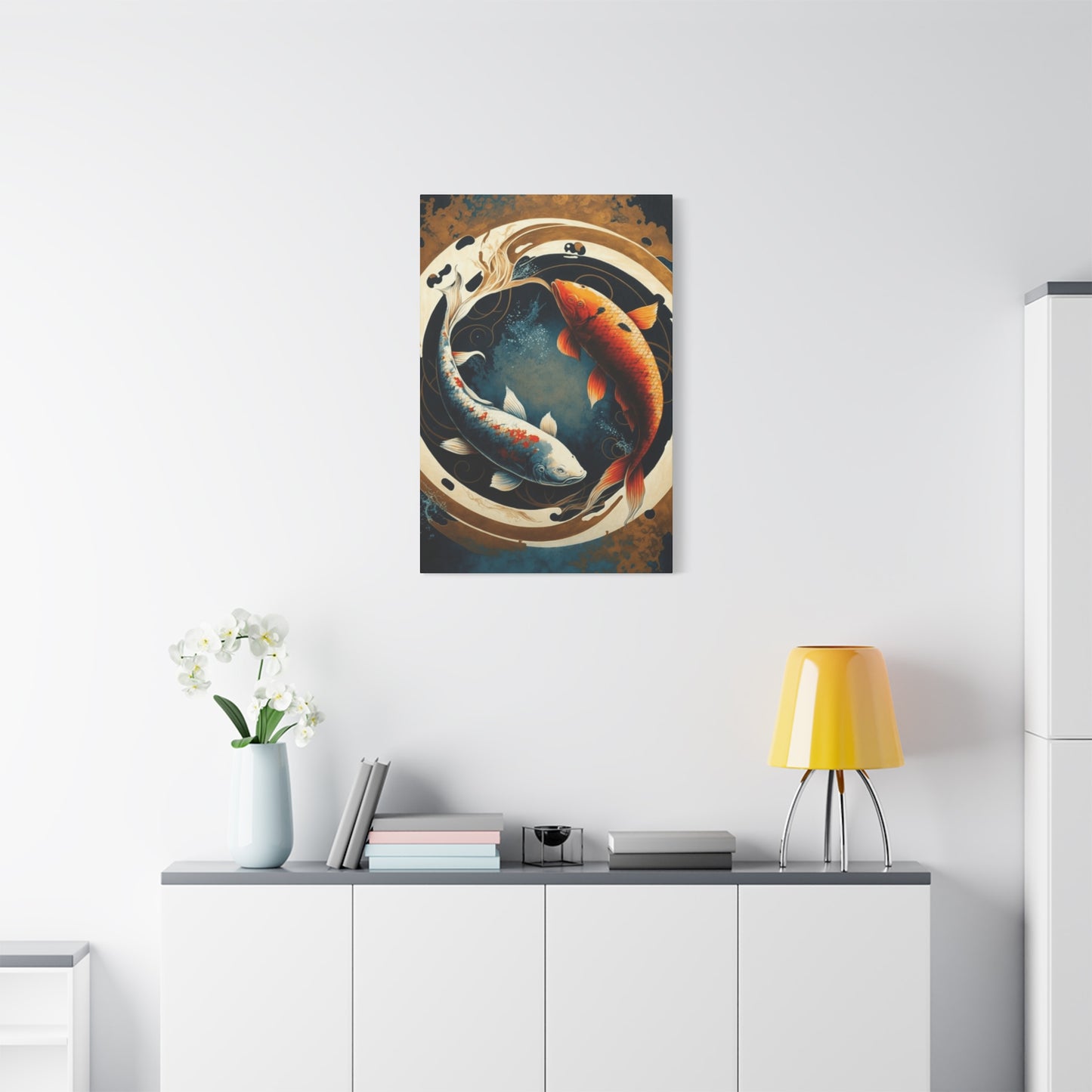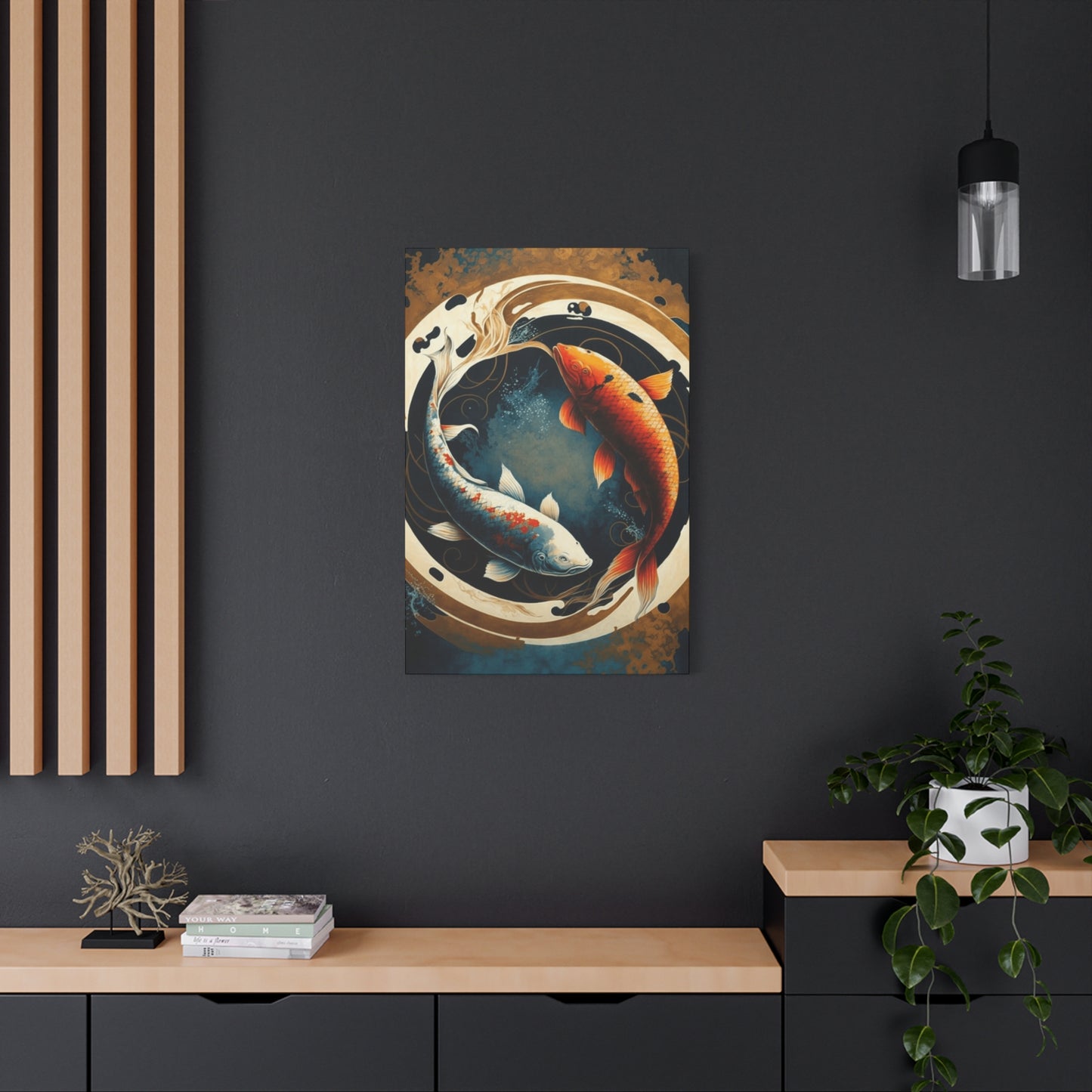Custom Koi Fish Wall Art: Collaborating with Artists to Get Your Vision
Koi fish wall art represents one of the most captivating and meaningful decorative elements you can incorporate into your living environment. These magnificent aquatic creatures have transcended their natural habitat to become powerful symbols of transformation, perseverance, and prosperity in homes worldwide. The art form captures not only the visual beauty of these remarkable fish but also carries deep cultural significance that can enhance the energy and atmosphere of any room.
The popularity of koi fish artwork has grown exponentially in recent years, as homeowners seek decorative pieces that offer both aesthetic appeal and spiritual meaning. Unlike conventional decorative elements, koi fish representations bring together artistic excellence with ancient wisdom, creating focal points that serve as daily reminders of life's most valuable lessons. From traditional Japanese ink paintings to contemporary digital prints, koi fish artwork adapts seamlessly to various decorative styles while maintaining its core symbolic power.
Understanding the rich heritage behind koi fish imagery allows homeowners to make informed choices about incorporating these pieces into their living environments. Each color variation, swimming direction, and artistic style carries specific meanings that can influence the energy flow and emotional resonance of a room. Whether you're drawn to the meditative qualities of swimming koi or the dynamic energy of leaping fish, these artworks offer endless possibilities for creating meaningful and beautiful living environments.
Profound Symbolism of Koi Fish in Wall Art
The symbolism embedded in koi fish wall art draws from centuries of Eastern philosophy and cultural tradition. These remarkable creatures represent transformation and personal growth, reflecting their natural ability to swim upstream against powerful currents. In Japanese culture, koi fish embody the concept of perseverance through adversity, making them particularly meaningful for individuals facing life challenges or seeking motivation for personal development.
The legend of the Dragon Gate tells the story of koi fish swimming upstream to reach a waterfall, where those who successfully leap over the falls transform into dragons. This powerful metaphor translates beautifully into wall art, where the image serves as a constant reminder that determination and persistence can lead to extraordinary achievements. Many homeowners choose koi fish artwork specifically for this inspirational message, placing these pieces in home offices, study areas, or meditation rooms where they can draw daily motivation from the imagery.
Different swimming patterns depicted in koi fish wall art carry distinct symbolic meanings. Koi swimming downstream represent letting go and accepting life's natural flow, while those swimming upstream symbolize determination and the willingness to face challenges head-on. Circular swimming patterns suggest the cyclical nature of life and the importance of balance, making these designs particularly popular in areas dedicated to reflection and contemplation.
The transformation symbolism extends beyond personal growth to encompass spiritual evolution and enlightenment. In Buddhist traditions, koi fish represent the journey from ignorance to wisdom, making these artworks meaningful additions to meditation rooms and spiritual practices. The gentle movements of koi through water mirror the flow of consciousness and the gradual progression toward higher understanding.
Seasonal symbolism also plays a significant role in koi fish artwork. Spring koi represent new beginnings and fresh opportunities, while autumn imagery symbolizes maturity and harvest of life's lessons. Summer koi embody abundance and vitality, and winter representations suggest patience and inner strength during challenging periods. These seasonal associations allow homeowners to select artwork that resonates with their current life circumstances or desired emotional states.
The water element surrounding koi in artistic representations carries its own symbolic weight. Water represents emotion, intuition, and the subconscious mind, creating a deeper layer of meaning when combined with koi imagery. This combination makes koi fish wall art particularly powerful for individuals seeking to enhance their emotional intelligence or connect more deeply with their intuitive abilities.
Koi Fish as Powerful Signs of Luck and Strength
Throughout Asian cultures, koi fish have long been revered as potent symbols of good fortune and inner strength. These associations make koi fish wall art particularly appealing to individuals seeking to enhance the positive energy in their homes while creating visually stunning focal points. The belief in koi fish as luck-bringing symbols stems from their remarkable resilience and adaptability, qualities that translate into protective and prosperous energy for living environments.
The strength symbolism of koi fish manifests in multiple ways throughout artistic representations. Physical strength is depicted through images of koi swimming against strong currents or leaping over obstacles, while emotional strength appears in serene koi navigating calm waters with grace and dignity. Mental strength is often represented through koi maintaining their course despite environmental challenges, making these artworks particularly meaningful for individuals facing difficult decisions or life transitions.
Lucky number associations further enhance the fortune-bringing properties of koi fish wall art. In Chinese culture, certain numbers of koi carry specific meanings: a single koi represents focused determination, two koi symbolize harmonious relationships, and groups of nine koi bring supreme good fortune. These numerical associations allow homeowners to select artwork that aligns with their specific intentions and goals, whether seeking love, career success, or general prosperity.
The colors of koi fish in wall art significantly impact their luck-bringing properties. Golden koi are considered the most auspicious, representing wealth and prosperity flowing into the home. Red koi symbolize love and passionate relationships, while black koi offer protection from negative energy. White koi represent spiritual purity and new beginnings, making them excellent choices for individuals entering new life phases or seeking spiritual growth.
Placement of luck-focused koi fish wall art requires careful consideration to maximize their beneficial effects. Positioning these pieces near entrances allows positive energy to flow throughout the home, while placement in wealth corners according to feng shui principles can enhance financial prosperity. Living rooms and family gathering areas benefit from koi artwork that promotes harmony and unity among household members.
The strength aspect of koi symbolism makes these artworks particularly valuable in challenging times. The visual reminder of koi perseverance can provide emotional support during difficult periods, while the artistic beauty offers a sense of calm and stability. Many individuals report feeling more resilient and capable when surrounded by koi fish imagery, suggesting that these symbols can indeed influence psychological well-being and inner strength.
Cultural variations in luck and strength symbolism allow koi fish wall art to resonate with diverse backgrounds and beliefs. Japanese interpretations focus on honor and courage, Chinese traditions emphasize prosperity and harmony, while contemporary Western applications often highlight personal empowerment and goal achievement. This cultural richness makes koi fish artwork universally appealing while maintaining specific relevance to individual heritage and values.
Exquisite Japanese-Style Koi Fish Canvas Designs
Japanese-style koi fish canvas designs represent the pinnacle of artistic tradition merged with contemporary home decoration. These sophisticated pieces draw from centuries of Japanese artistic heritage, incorporating traditional techniques and aesthetic principles that have been refined through generations of master artists. The resulting artworks offer homeowners the opportunity to bring authentic cultural beauty into their living environments while honoring the deep spiritual and artistic traditions of Japan.
Traditional Japanese koi art employs specific color palettes that reflect natural harmony and seasonal awareness. Soft earth tones dominate many pieces, with subtle variations of brown, gold, and muted orange creating depth and movement. These natural color schemes allow Japanese-style koi canvas designs to integrate seamlessly with various decorative approaches, from contemporary minimalism to traditional Asian-inspired themes. The restrained use of color reflects the Japanese aesthetic principle of finding beauty in simplicity and natural expression.
Brushwork techniques characteristic of Japanese art create distinctive textures and movement in koi fish canvas designs. Flowing, organic lines capture the graceful movement of koi through water, while varying brush pressures create depth and dimension that brings the fish to life on canvas. These traditional techniques, when translated to modern canvas printing, maintain their emotional impact and artistic integrity while offering the durability and accessibility of contemporary art reproduction.
Compositional elements in Japanese-style koi designs follow established principles of balance and harmony. Asymmetrical arrangements create dynamic visual interest while maintaining overall equilibrium, reflecting the Japanese concept of finding perfect balance within apparent randomness. Negative spaces play crucial roles in these compositions, allowing the eye to rest and creating breathing room that enhances the overall impact of the koi imagery.
Water representation in Japanese koi canvas art demonstrates sophisticated understanding of flow and movement. Rather than attempting photorealistic water depiction, traditional Japanese approaches use stylized wave patterns and flowing lines that suggest water's essence without literal representation. These artistic interpretations often prove more emotionally resonant than realistic water imagery, capturing the spiritual and emotional qualities of the aquatic environment rather than just its physical appearance.
Seasonal elements frequently appear in authentic Japanese koi canvas designs, connecting the artwork to natural cycles and traditional cultural celebrations. Cherry blossoms accompanying spring koi create romantic and hopeful compositions, while autumn maple leaves paired with mature koi suggest wisdom and life experience. These seasonal references add layers of meaning and allow homeowners to select pieces that resonate with their personal experiences or desired emotional atmospheres.
Contemporary applications of Japanese-style koi designs successfully bridge traditional artistry with modern living requirements. Large-scale canvas prints bring the meditative qualities of traditional Japanese art into contemporary homes, while maintaining the cultural authenticity and spiritual significance that makes these pieces so compelling. The durability and versatility of modern canvas printing techniques ensure that these traditional designs can withstand contemporary living conditions while retaining their artistic integrity.
Modern interpretations of Japanese koi art often incorporate traditional elements with contemporary perspectives, creating hybrid pieces that honor cultural heritage while speaking to contemporary audiences. These adaptations might include traditional koi rendered in contemporary color schemes or classical compositions presented in modern proportions and formats. Such approaches make Japanese-style koi art accessible to diverse decorative preferences while maintaining cultural respect and artistic authenticity.
Koi Fish Wall Art for Creating Calming Environments
The inherent tranquility associated with koi fish makes them ideal subjects for artwork intended to create peaceful and calming environments. These serene creatures, gliding gracefully through water, naturally evoke feelings of relaxation and inner peace, making koi fish wall art particularly valuable in today's fast-paced world where creating peaceful home sanctuaries has become increasingly important.
The visual rhythm created by swimming koi naturally slows down mental activity and encourages relaxation. The flowing, curved lines of koi bodies and the gentle ripples they create in water translate into artistic compositions that guide the eye in smooth, meditative movements across the canvas. This visual flow helps reduce stress and anxiety, creating environments conducive to rest, reflection, and emotional restoration.
Color psychology plays a crucial role in the calming effects of koi fish artwork. Soft blues and greens commonly used in water backgrounds promote feelings of tranquility and peace, while warm, muted tones in the koi themselves add comfort without overwhelming the senses. The careful balance between cool and warm colors in well-designed koi artwork creates harmonious environments that support relaxation and emotional well-being.
Bedroom applications of calming koi fish wall art require specific considerations to maximize their peaceful effects. Soft, muted colors work best in sleeping areas, promoting rest and preventing overstimulation before sleep. Gentle, downstream-swimming koi create the most restful imagery, suggesting ease and natural flow rather than struggle or effort. The placement of these pieces should allow for viewing from the bed while maintaining appropriate feng shui principles for bedroom harmony.
Living room installations of calming koi artwork can transform social gathering areas into peaceful retreats. Large-scale pieces featuring multiple koi in serene pond settings create focal points that encourage conversation while maintaining peaceful atmospheres. The natural beauty of koi imagery provides neutral topics for discussion while the calming visual elements help reduce social anxiety and promote comfortable interactions.
Bathroom and spa-like environments benefit enormously from koi fish wall art designed for relaxation. The natural aquatic themes complement water-focused rooms while the peaceful symbolism enhances the restorative qualities of these personal retreat areas. Moisture-resistant canvas treatments ensure that bathroom installations remain beautiful and durable despite humid conditions.
Meditation and yoga rooms represent ideal applications for calming koi fish artwork. The meditative qualities inherent in koi imagery support contemplative practices, while the symbolic associations with spiritual growth enhance the sacred atmosphere of these dedicated practicing areas. Positioning artwork at eye level during seated meditation allows for gentle focus points that support concentration without distraction.
Office and work environment applications of calming koi art help balance the stress and pressure common in professional settings. The peaceful imagery provides mental breaks during intense work periods, while the symbolic associations with perseverance and success offer motivation without aggression. Home office installations particularly benefit from koi artwork, as it helps maintain work-life balance by introducing calming elements into productive environments.
Comprehensive Feng Shui Benefits of Koi Fish Prints
Feng shui principles recognize koi fish as powerful symbols for enhancing positive energy flow throughout living environments. The ancient Chinese art of harmonizing human energy with surrounding environments finds particular value in koi fish imagery due to their natural associations with water, movement, and prosperity. Understanding these feng shui applications allows homeowners to strategically position koi fish prints for maximum benefit in creating harmonious and prosperous living conditions.
The water element represented by koi fish artwork brings essential balance to feng shui energy systems. Water symbolizes wealth, wisdom, and emotional depth in feng shui philosophy, making koi prints valuable tools for enhancing these qualities in homes. The flowing movement of water around koi creates dynamic energy that prevents stagnation while maintaining gentle, nourishing qualities that support growth and prosperity.
Directional placement of koi fish prints according to feng shui principles maximizes their beneficial effects on household energy. North-facing walls receive particular benefit from koi artwork, as this direction associates with career success and life path clarity. The swimming direction of koi in these prints should generally flow toward the center of the home, drawing positive energy inward and promoting accumulation of beneficial influences.
Wealth corner applications of koi fish prints offer specific feng shui benefits for financial prosperity. The southeast corner of homes or individual rooms represents the wealth sector according to traditional feng shui mapping. Positioning koi artwork in these areas, particularly pieces featuring golden or abundant koi, can enhance the flow of prosperity energy while maintaining the gentle, sustainable qualities associated with long-term financial success.
Color considerations in feng shui koi fish prints require careful attention to achieve desired energy effects. Black koi promote protection and absorb negative energy, making them suitable for areas requiring energetic cleansing. Red koi enhance passion and relationships, while golden koi specifically attract wealth and opportunity. Blue koi support wisdom and learning, making them excellent choices for study areas and educational environments.
Family harmony benefits from appropriately positioned koi fish artwork in central gathering areas. The peaceful nature of koi imagery reduces conflict energy while promoting understanding and cooperation among household members. Pairs of koi swimming together particularly enhance relationship harmony and partnership energy throughout the home.
Health sector enhancement through koi fish prints supports physical and emotional well-being according to feng shui principles. The east sector of homes governs health and family relationships, making it an ideal location for koi artwork that promotes vitality and healing energy. The natural, life-affirming qualities of koi imagery contribute to overall wellness and recovery from illness or stress.
Career and reputation benefits result from strategic placement of koi fish prints in relevant feng shui sectors. The south wall governs reputation and recognition, while north walls influence career progress and professional opportunities. Koi swimming upstream in these locations symbolize determination and professional advancement, while multiple koi suggest teamwork and collaborative success.
Modern applications of feng shui principles with koi fish artwork adapt ancient wisdom to contemporary living situations. Apartment dwellers can apply feng shui benefits through careful room-by-room placement, while large homes can create comprehensive energy enhancement systems using multiple koi prints positioned according to traditional principles. The key lies in understanding the underlying energy principles rather than rigid adherence to traditional placement rules.
Using Koi Fish Art in Minimalist Home Environments
Minimalist decorating approaches find perfect harmony with thoughtfully selected koi fish artwork, as these pieces can provide meaningful focal points without cluttering clean, simplified environments. The natural elegance and symbolic depth of koi imagery align beautifully with minimalist principles of purposeful decoration, where every element must earn its place through both aesthetic value and personal significance.
Single statement pieces featuring koi fish artwork work exceptionally well in minimalist settings, providing visual interest and emotional resonance without overwhelming clean lines and open areas. Large-scale koi prints or paintings can anchor entire rooms while maintaining the spacious feeling essential to minimalist aesthetics. The key lies in selecting pieces with sufficient visual impact to command attention while complementing rather than competing with architectural elements.
Color coordination becomes crucial when incorporating koi fish art into minimalist environments. Monochromatic koi pieces in black, white, and gray tones integrate seamlessly with neutral minimalist palettes while adding organic curves and natural movement to geometric surroundings. Limited color schemes featuring single accent colors can introduce warmth and life without compromising the clean aesthetic that defines minimalist design.
Negative space utilization in minimalist koi artwork mirrors the principles of minimalist room design, where empty areas serve important compositional functions. Koi prints featuring plenty of white or neutral background space complement minimalist environments by respecting the importance of visual breathing room. These pieces add interest without visual weight, maintaining the sense of openness essential to successful minimalist decorating.
Material considerations for minimalist koi fish artwork favor clean, modern presentation methods. Simple white or natural wood frames maintain focus on the artwork itself while complementing minimalist furniture and architectural elements. Frameless mounting or floating presentation techniques can create striking modern effects that honor both the artwork and the minimalist aesthetic principles.
Placement strategies in minimalist rooms require careful consideration of sight lines and visual balance. Single koi pieces work best as focal points on otherwise empty walls, while multiple smaller pieces can create interesting compositions when arranged with plenty of surrounding negative areas. The goal involves creating visual anchors that enhance rather than complicate the minimalist environment.
Lighting design plays a crucial role in displaying koi fish artwork within minimalist settings. Clean, focused lighting can dramatically enhance the impact of koi pieces while maintaining the uncluttered aesthetic that defines minimalist environments. Track lighting or picture lights provide focused illumination without adding visual clutter, while natural light positioning can create changing effects throughout the day.
Texture considerations become more important in minimalist settings where every surface and element receives increased attention. Koi artwork can introduce organic textures and natural movement to environments dominated by smooth, manufactured surfaces. Canvas textures, paper qualities, and printing techniques all contribute to the tactile richness that prevents minimalist environments from feeling cold or sterile.
Integration with minimalist furniture requires careful attention to scale and proportion. Oversized koi artwork can create dramatic effects above low-profile minimalist furniture, while smaller pieces might get lost against large, simple furnishings. The goal involves creating purposeful relationships between artwork and furnishings that enhance both elements without creating visual competition.
Deep Color Meanings in Koi Fish Artwork
Color symbolism in koi fish artwork carries profound meaning that extends far beyond simple aesthetic preferences. Each hue represents specific qualities, emotions, and aspirations, allowing homeowners to select pieces that align with their personal goals and desired environmental energies. Understanding these color associations enables more intentional decorating choices that support both visual appeal and meaningful symbolism.
Golden koi fish artwork represents the pinnacle of prosperity symbolism, with these radiant creatures embodying wealth, success, and abundant opportunity. The warm, luminous quality of gold creates inviting and optimistic environments while attracting positive energy associated with financial abundance. Golden koi pieces work particularly well in wealth corners according to feng shui principles or in areas where business decisions and financial planning take place.
Red koi fish imagery pulsates with passionate energy, symbolizing love, strength, and powerful emotions. These vibrant pieces bring warmth and vitality to living environments while representing the courage needed to pursue deep relationships and meaningful connections. Red koi artwork suits romantic bedroom settings or areas where family gathering and emotional bonding occur regularly.
Black koi fish artwork carries protective and mysterious qualities, representing wisdom gained through life experience and the ability to absorb negative energy. These sophisticated pieces add depth and gravitas to environments while providing energetic protection against harmful influences. Black koi works well in meditation areas, studies, or rooms where serious contemplation and decision-making occur.
White koi fish art symbolizes spiritual purity, new beginnings, and fresh starts. These clean, hopeful images create peaceful environments conducive to meditation, healing, and personal transformation. White koi pieces particularly suit bedrooms, bathrooms, and other personal retreat areas where renewal and restoration take place.
Blue koi fish artwork embodies tranquility, wisdom, and emotional depth. The cool, calming nature of blue koi creates serene environments perfect for relaxation and contemplation. These pieces work exceptionally well in bedrooms, home offices, and other areas where mental clarity and emotional balance are desired.
Orange koi fish imagery radiates joy, creativity, and enthusiastic energy. These vibrant pieces encourage optimism and creative expression while maintaining the gentle qualities associated with koi symbolism. Orange koi artwork suits creative workrooms, children's areas, and social gathering places where positive energy and inspiration are welcomed.
Multi-colored koi fish art combinations create complex symbolic meanings that reflect life's diversity and richness. Rainbow koi pieces suggest completeness and harmony between different life aspects, while contrasting color combinations might represent balance between opposing forces or qualities. These complex pieces suit main living areas where multiple family members gather and diverse energies converge.
Silver koi fish artwork represents intuition, reflection, and lunar feminine energy. These subtle, sophisticated pieces create contemplative environments while honoring the quieter, more introspective aspects of personal development. Silver koi works well in private areas where reflection and emotional processing take place.
Color combination effects in koi fish artwork create layered symbolic meanings that can address multiple life areas simultaneously. Gold and red combinations suggest passionate prosperity, while black and white pairings represent balanced wisdom. Understanding these combinations allows for more nuanced decorating choices that address complex personal and family needs.
Seasonal color associations in koi fish artwork connect these pieces to natural cycles and traditional cultural celebrations. Spring colors like light green and pink suggest renewal and growth, while autumn tones represent maturity and harvest of life lessons. These seasonal connections allow homeowners to select artwork that resonates with current life phases or desired seasonal energies.
Koi Pond Scenes as Sophisticated Wall Decorations
Koi pond scene artwork brings the complete aquatic environment into home decorating, creating immersive experiences that transport viewers to peaceful water gardens. These comprehensive compositions offer more complex visual narratives than individual koi portraits while maintaining the symbolic power and aesthetic appeal that makes koi fish imagery so compelling for home decoration.
Naturalistic pond scenes featuring koi in their environmental context provide educational and inspirational benefits beyond simple decoration. These detailed compositions showcase the complex ecosystems that support koi life while demonstrating the harmony possible between human cultivation and natural processes. Viewers can study the intricate relationships between water plants, fish, and environmental elements while enjoying the meditative qualities of complete pond imagery.
Artistic interpretations of koi pond scenes range from photorealistic representations to highly stylized compositions that emphasize symbolic and emotional content over literal accuracy. Impressionistic approaches might focus on light and movement across pond surfaces, while abstract interpretations could emphasize the energetic qualities of flowing water and swimming fish. These varied artistic approaches allow homeowners to select pond scene artwork that matches their aesthetic preferences and decorative themes.
Seasonal pond scenes offer opportunities to connect koi fish artwork with natural cycles and changing environmental conditions. Spring pond scenes featuring blooming water lilies and active young koi celebrate renewal and fresh beginnings, while autumn compositions with mature koi among fallen leaves suggest wisdom and life experience. Winter pond scenes create contemplative moods perfect for quiet reflection and inner development.
Large-scale pond scene murals can transform entire walls into peaceful water garden experiences. These immersive installations create the illusion of looking out into actual pond environments, making rooms feel larger and more connected to nature. The meditative qualities of pond scenes make them particularly suitable for bedrooms, meditation areas, and other rooms where tranquility and peace are desired.
Water feature elements in pond scene artwork contribute significantly to the overall calming effects of these pieces. Gentle waterfalls, floating lily pads, and rippling water surfaces create visual movement that naturally reduces stress and promotes relaxation. The sound associations triggered by water imagery can enhance the peaceful atmosphere even though the artwork itself remains silent.
Garden context elements in koi pond scenes connect these aquatic environments to broader landscape design principles. Surrounding rocks, plants, and architectural elements demonstrate how koi ponds integrate into complete outdoor living environments. This broader context can inspire homeowners to consider outdoor water features while enjoying the beauty of pond imagery indoors.
Lighting effects in pond scene artwork create depth and atmosphere that enhance the immersive qualities of these pieces. Dappled sunlight filtering through water surfaces, reflected light patterns, and subtle shadowing all contribute to realistic and engaging pond environments. These lighting effects work particularly well when actual room lighting complements the lighting depicted in the artwork.
Multiple panel pond scenes create opportunities for large-scale installations that can span entire walls or room sections. These comprehensive compositions allow for detailed storytelling while maintaining manageable individual panel sizes for practical installation and future rearrangement. Sequential panels might show different pond areas or times of day, creating dynamic experiences that change based on viewing position.
Pond scene artwork integration with actual water features creates sophisticated decorating schemes that blur the lines between indoor and outdoor environments. Fountain or aquarium placement near pond scene artwork can create multimedia experiences that engage multiple senses while maintaining harmonious design themes. These combinations work particularly well in rooms with good natural light and connections to outdoor garden areas.
Traditional Versus Modern Koi Fish Art Approaches
The evolution of koi fish art from traditional cultural expressions to contemporary decorative pieces reflects broader changes in how we understand and integrate cultural symbols into modern living environments. Understanding the distinctions between traditional and modern approaches helps homeowners make informed decisions about which styles best serve their decorating goals and cultural perspectives.
Traditional koi fish art draws from centuries of cultural development in East Asian societies, particularly Japan and China, where these images carry deep spiritual and cultural significance. Traditional techniques emphasize flowing brushwork, natural pigments, and compositional principles that have been refined through generations of master artists. These pieces often incorporate calligraphy, seasonal symbols, and cultural references that require cultural knowledge to fully appreciate.
Historical techniques used in traditional koi fish art include sumi-e ink painting, where gradations of black ink create depth and movement, and traditional watercolor methods that capture the translucent qualities of water and the subtle coloring of koi scales. These techniques produce distinctive visual textures and emotional qualities that differ significantly from contemporary reproduction methods.
Cultural authenticity in traditional koi fish art requires understanding the original contexts and meanings behind artistic choices. Traditional pieces often include specific symbolic elements, color combinations, and compositional arrangements that carry cultural significance beyond simple aesthetic appeal. Respect for these cultural traditions becomes important when displaying traditional koi art in contemporary settings.
Modern koi fish art adaptations transform traditional imagery for contemporary audiences and decorating requirements. Digital printing techniques allow for large-scale reproductions and color variations that wouldn't be possible with traditional methods. Contemporary artists often reinterpret traditional koi imagery through modern artistic lenses, creating hybrid pieces that honor cultural heritage while speaking to current aesthetic preferences.
Contemporary color palettes in modern koi art might include vibrant hues and color combinations that don't appear in traditional pieces but work well with current decorating trends. Neon accents, metallic finishes, and unconventional color schemes can create striking modern effects while maintaining the recognizable forms and symbolic content of koi imagery.
Artistic freedom in modern koi art allows for experimental approaches that might include abstract interpretations, mixed media techniques, and non-traditional materials. Contemporary artists might combine koi imagery with modern graphic elements, photography, or digital manipulation to create entirely new artistic expressions that maintain symbolic connections to traditional koi meanings.
Size and scale considerations differ significantly between traditional and modern koi art applications. Traditional pieces often follow established proportional relationships and size conventions, while modern applications might include oversized statement pieces, miniature detail studies, or unusual proportional arrangements designed for specific contemporary decorating requirements.
Installation differences between traditional and modern koi art reflect different cultural approaches to displaying artwork. Traditional pieces might require specific mounting techniques, viewing distances, and contextual elements that honor their cultural origins, while modern pieces often adapt easily to contemporary hanging systems and room arrangements.
Hybrid approaches combining traditional and modern elements create unique opportunities for homeowners who appreciate both cultural authenticity and contemporary design requirements. These pieces might use traditional imagery with modern materials, conventional techniques with contemporary colors, or historical compositions adapted for modern room proportions.
Market accessibility differs significantly between traditional and modern koi art, with traditional pieces often requiring specialized knowledge and higher investment, while modern reproductions and interpretations offer broader accessibility and varied price points. Understanding these differences helps homeowners make appropriate choices based on their cultural interests, budget considerations, and decorating goals.
Popular Koi Fish Wall Art for Bedroom Environments
Bedroom applications of koi fish wall art require careful consideration of the unique requirements of personal retreat and sleeping environments. The peaceful, meditative qualities inherent in koi imagery make these pieces naturally suitable for bedrooms, but specific design choices can enhance their beneficial effects on rest, relaxation, and intimate personal environments.
Calming color schemes work best for bedroom koi fish artwork, with soft blues, gentle greens, and muted earth tones creating peaceful atmospheres conducive to rest and relaxation. Overly vibrant or energetic colors might interfere with sleep preparation, while harsh contrasts can create visual stimulation that works against the bedroom's primary function as a retreat from daily stress and activity.
Downstream swimming koi imagery promotes rest and ease in bedroom settings, as these compositions suggest going with the flow rather than struggling against currents. The gentle, effortless movement depicted in downstream swimming creates visual associations with relaxation and letting go of daily tensions. This imagery particularly benefits individuals who have difficulty winding down from busy or stressful days.
Bedroom lighting considerations affect how koi fish artwork appears during different times of day and various lighting conditions. Soft, warm lighting enhances the peaceful qualities of koi imagery while harsh or bright lighting might interfere with the calming effects. Dimmable lighting systems allow for adjustment based on time of day and desired mood, with evening dimming supporting sleep preparation.
Placement strategies for bedroom koi art should consider feng shui principles and practical viewing angles. Artwork positioned to be visible from the bed can provide peaceful focus points for meditation or quiet contemplation, while pieces placed opposite the bed create welcoming visual elements upon entering the room. Avoiding direct alignment with the foot of the bed respects traditional feng shui recommendations for bedroom harmony.
Size proportions in bedroom koi art should complement rather than overwhelm the intimate scale typical of sleeping areas. Oversized pieces might dominate small bedrooms and interfere with the cozy atmosphere many people prefer for rest, while undersized pieces might get lost against large furniture or expansive wall areas. Medium-scale pieces often work best, providing visual interest without overwhelming intimate bedroom proportions.
Partner consideration becomes important when selecting koi fish artwork for shared bedrooms. Symbolic meanings should resonate with both individuals, while aesthetic preferences require compromise and discussion. Pieces featuring paired koi swimming together can symbolize partnership harmony, making them particularly appropriate for shared sleeping areas.
Seasonal bedroom themes can be enhanced through careful selection of koi fish artwork that reflects desired seasonal moods. Spring koi imagery with fresh, growing elements supports renewal and fresh beginnings, while autumn compositions create cozy, reflective atmospheres perfect for intimate personal retreats. These seasonal connections can be changed periodically to maintain visual interest and emotional resonance.
Material considerations for bedroom koi art might favor softer textures and finishes that complement textile elements common in bedroom decorating. Canvas prints with subtle textures work well with fabric headboards and soft furnishings, while glossy finishes might create unwanted glare or visual hardness that conflicts with bedroom comfort requirements.
Privacy and intimacy enhancement through koi fish artwork can support the bedroom's role as a personal sanctuary. Pieces with peaceful, private pond settings suggest secluded retreat areas, while imagery showing koi in protected, enclosed water environments can reinforce feelings of safety and security important for quality rest and intimate relationships.
Water-Themed Home Enhancement with Koi Fish Prints
Water-themed decorating schemes find natural harmony with koi fish prints, as these aquatic creatures provide focal points that enhance broader water-inspired design concepts. The combination of water symbolism with the specific meanings associated with koi fish creates layered decorative themes that can transform entire rooms into peaceful, flowing environments reminiscent of natural water gardens.
Bathroom transformations using koi fish prints create spa-like atmospheres that enhance the relaxation and renewal associated with water-focused rooms. The natural aquatic themes complement bathroom functions while the peaceful symbolism of koi adds meditative qualities to daily routines. Moisture-resistant mounting techniques ensure that bathroom koi installations remain beautiful and durable despite humid conditions typical of these environments.
Kitchen water themes can be enhanced through carefully selected koi fish artwork that complements without overwhelming food preparation areas. Small koi prints near sink areas or breakfast nooks can add peaceful elements to busy kitchen environments, while larger pieces in dining areas connected to kitchens can create harmonious flow between cooking and eating areas. The life-sustaining symbolism of both water and fish creates appropriate associations with nourishment and family care.
Pool and spa area decorating benefits enormously from koi fish artwork that bridges indoor and outdoor aquatic environments. Weather-resistant koi prints designed for outdoor or high-humidity installation can create visual connections between artificial water features and natural aquatic life. These installations work particularly well in pool houses, covered outdoor areas, and rooms with direct pool or spa access.
Fountain coordination with koi fish artwork creates multimedia water experiences that engage both visual and auditory senses. The sound of flowing water from actual fountains combines with the visual movement suggested by koi imagery to create immersive aquatic environments. These combinations work particularly well in meditation rooms, entryways, and other areas where peaceful, welcoming atmospheres are desired.
Aquarium room themes find natural enhancement through koi fish artwork that complements actual fish-keeping activities. The artwork can provide visual interest during aquarium maintenance periods or create backup focal points when tanks are temporarily out of service. The combination of living fish with koi imagery creates rich aquatic environments that celebrate both natural life and artistic interpretation.
Blue and green color schemes dominate successful water-themed rooms featuring koi fish artwork. These natural water colors create cohesive environments while providing peaceful, cooling effects particularly valuable in warm climates or rooms with significant sun exposure. Varying shades and intensities of water colors prevent monotony while maintaining thematic consistency throughout room designs.
Texture combinations in water-themed rooms might include smooth surfaces that suggest water flow along with natural textures that evoke pond environments. Koi fish artwork can bridge these textural elements by providing organic curves and natural forms that soften hard architectural elements while complementing natural materials like stone and wood often used in water-themed decorating.
Lighting design for water-themed rooms with koi fish artwork can simulate the quality of light found in actual aquatic environments. Soft, diffused lighting creates underwater effects, while focused lighting can create ripple patterns and movement effects that enhance the water theme. Colored lighting gels in blue and green tones can create particularly effective aquatic atmospheres during evening hours.
Plant coordination with water-themed koi fish artwork creates complete aquatic garden environments indoors. Water-loving plants like ferns and tropical species complement koi imagery while supporting the broader water theme through their lush, moisture-loving growth patterns. These living elements add authentic natural qualities that enhance the artificial aquatic environments created through artwork and decorative elements.
Black and Gold Koi Fish Art Current Trends
The sophisticated color combination of black and gold in koi fish artwork represents one of the most elegant and contemporary trends in aquatic-themed home decoration. This striking palette combines the mysterious depth of black koi with the prosperous radiance of golden elements, creating pieces that work beautifully in both traditional and contemporary decorating schemes while maintaining powerful symbolic significance.
Luxury appeal drives much of the current popularity of black and gold koi fish artwork. The combination suggests opulence and sophistication while avoiding the ostentation that might characterize more obviously wealthy decorative choices. These pieces provide subtle luxury that enhances upscale environments without overwhelming other decorative elements or appearing unnecessarily flashy.
Contemporary decorating trends favor the dramatic contrast possible with black and gold combinations, as these colors create striking visual effects that work well in modern minimalist settings. The bold color contrast draws attention and creates focal points while the koi imagery adds organic curves and natural movement that soften contemporary architectural elements. This balance between dramatic color and gentle imagery appeals to current aesthetic preferences.
Conclusion:
Custom koi fish wall art offers a beautiful way to bring a personal and meaningful touch to your living space, blending artistry with symbolism. Koi fish, known for their grace, perseverance, and good fortune, have long been cherished in various cultures, especially in Japanese tradition. Creating custom wall art featuring koi fish allows you to celebrate these qualities while crafting a unique piece that reflects your individual style and story.
The process of collaborating with an artist to bring your koi fish vision to life is both exciting and deeply rewarding. It begins with sharing your ideas, inspirations, and preferences—whether that means focusing on specific colors, styles, or symbolic elements like water lilies, waves, or traditional Japanese patterns. A skilled artist can then interpret your concepts into sketches or digital mock-ups, providing an opportunity for feedback and refinement. This back-and-forth collaboration ensures the final artwork aligns perfectly with your expectations.
One of the most appealing aspects of custom koi fish art is the flexibility it offers. You can choose from a wide range of mediums such as watercolor, acrylic, ink, or mixed media, each bringing a different texture and mood to the piece. Additionally, the scale of the artwork can be tailored to fit any room, from a small, intimate piece for a bedroom nook to a bold mural that commands attention in a living area.
Beyond aesthetics, custom koi fish wall art adds layers of meaning and personality to your home. It becomes a conversation starter, a symbol of your journey, and a source of daily inspiration. By working directly with an artist, you also support creative talent, contributing to a one-of-a-kind masterpiece that holds both artistic and sentimental value.
In conclusion, custom koi fish wall art is more than decoration—it’s a collaborative journey toward creating a meaningful and stunning focal point. With the right artist partnership, you can turn your vision into an exquisite reality, enriching your space with beauty, symbolism, and personal significance.













